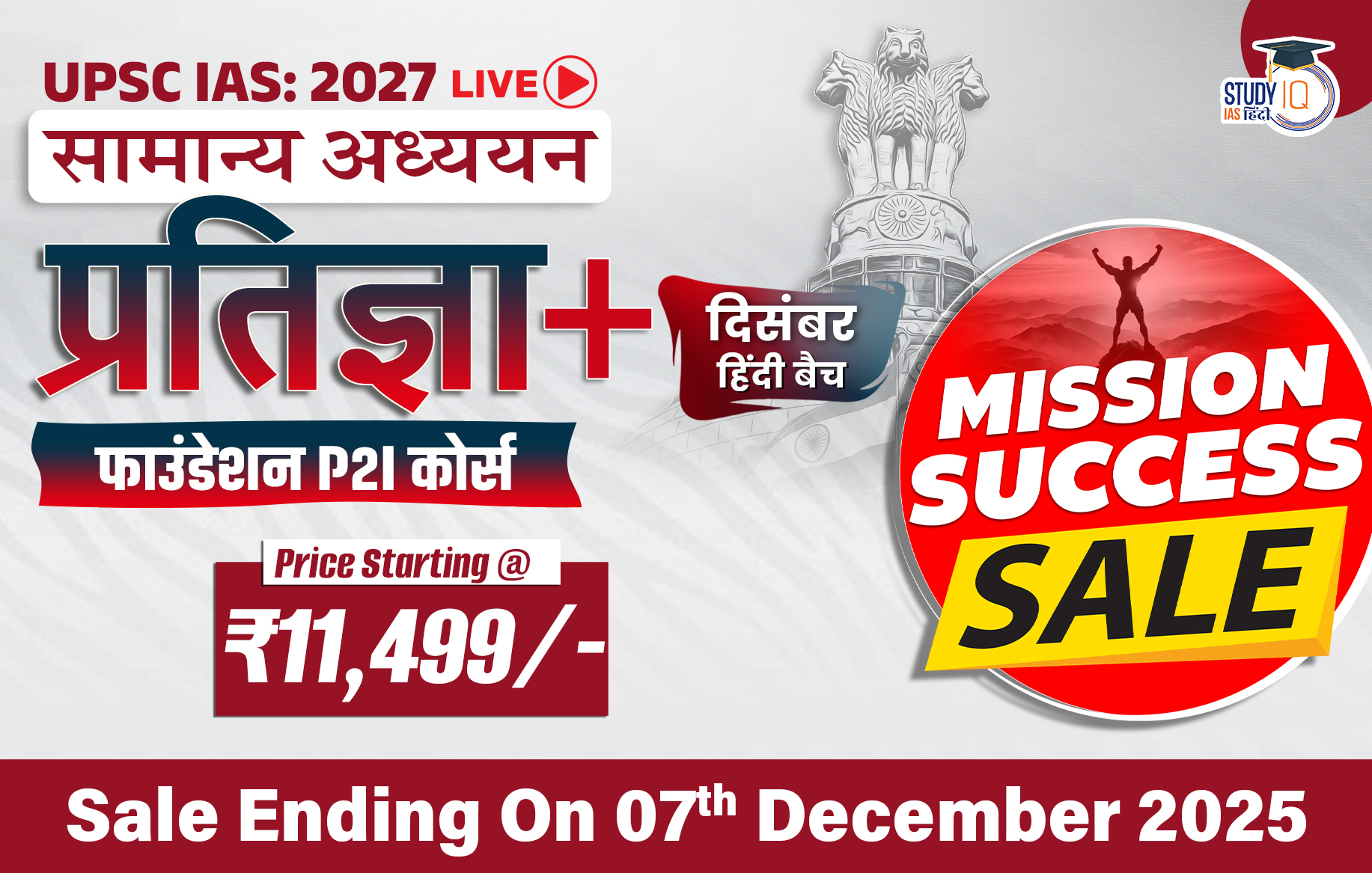Daily Quiz 19 June 2024
Quiz-summary
0 of 5 questions completed
Questions:
- 1
- 2
- 3
- 4
- 5
Information
- Click on – ‘Start Quiz’ button
- Solve Questions
- Click on ‘Next’ button
- Click on ‘Finish Quiz’ button
- Now click on ‘View Questions’ button – here you will see solutions and links.
- The test contains a total of 5 questions.
- Click on the most appropriate option to mark it as your answer.
- You will be awarded Two marks for each correct answer.
- You can change your answer by clicking on some other option.
- A Number list of all questions appears at the top side of the screen.
- You can access the questions in any order by clicking on the question number given on the number list.
- You can use rough sheets while taking the test.
- Do not use calculators, log tables, dictionaries, or any other printed/online reference material during the test.
- Do not click the button “Finish Quiz” before completing the test. A test once submitted cannot be resumed.
You have already completed the quiz before. Hence you can not start it again.
Quiz is loading...
You must sign in or sign up to start the quiz.
You have to finish following quiz, to start this quiz:
- 1
- 2
- 3
- 4
- 5
- Answered
- Review
-
Question 1 of 5
1. Question
1 pointsWith reference to Foreign Portfolio Investments (FPI), consider the following statements:
- Investments made by Non-Resident Indians (NRIs) are classified as FPI.
- FPI is more liquid than Foreign Direct Investment (FDI).
- FPI allows the investor with direct ownership of a company’s assets.
Which of the statements given above are correct?
Correct
Answer: B
Explanation:
- Statement 1 is Incorrect: Foreign portfolio investment (FPI) consists of securities and other financial assets held by investors in another country.
- It includes various forms like stocks, bonds, mutual funds, exchange-traded funds, American Depositary Receipts (ADRs), and Global Depositary Receipts (GDRs).
- FPI is a component of a country’s capital account and appears on its Balance of Payments (BOP), which tracks monetary exchanges between countries over a fiscal year.
- In India, it is regulated by the the Securities and Exchange Board of India (SEBI) under FPI Regulations in 2019, replacing the older 2014 regulations.
- Investments made by Non-Resident Indians (NRIs) are not classified as FPI.
- Statement 2 is Correct: Foreign Portfolio Investment (FPI) is often referred as “hot money,” for its liquidity and volatility due to the nature of the assets involved and the ease with which they can be traded.
- FPI involves purchasing financial assets such as stocks, bonds, and other securities in a foreign country. These assets are typically traded on public markets and can be bought and sold quickly.
- WHile Foreign Direct Investment (FDI) includes investment from foreign entities in a company in another country. This investment is typically aimed at long-term engagement.
- Statement 3 is Incorrect: Foreign Portfolio Investment (FPI) does not provide investors with direct ownership of a company’s assets. FPI typically involves holding financial assets such as stocks, bonds, and other securities in another country. These investments are considered passive, meaning the investor does not have control over the ventures or direct ownership of property or a stake in a company.
Incorrect
Answer: B
Explanation:
- Statement 1 is Incorrect: Foreign portfolio investment (FPI) consists of securities and other financial assets held by investors in another country.
- It includes various forms like stocks, bonds, mutual funds, exchange-traded funds, American Depositary Receipts (ADRs), and Global Depositary Receipts (GDRs).
- FPI is a component of a country’s capital account and appears on its Balance of Payments (BOP), which tracks monetary exchanges between countries over a fiscal year.
- In India, it is regulated by the the Securities and Exchange Board of India (SEBI) under FPI Regulations in 2019, replacing the older 2014 regulations.
- Investments made by Non-Resident Indians (NRIs) are not classified as FPI.
- Statement 2 is Correct: Foreign Portfolio Investment (FPI) is often referred as “hot money,” for its liquidity and volatility due to the nature of the assets involved and the ease with which they can be traded.
- FPI involves purchasing financial assets such as stocks, bonds, and other securities in a foreign country. These assets are typically traded on public markets and can be bought and sold quickly.
- WHile Foreign Direct Investment (FDI) includes investment from foreign entities in a company in another country. This investment is typically aimed at long-term engagement.
- Statement 3 is Incorrect: Foreign Portfolio Investment (FPI) does not provide investors with direct ownership of a company’s assets. FPI typically involves holding financial assets such as stocks, bonds, and other securities in another country. These investments are considered passive, meaning the investor does not have control over the ventures or direct ownership of property or a stake in a company.
-
Question 2 of 5
2. Question
1 pointsSolar Ultraviolet Imaging Telescope (SUIT) and Visible Emission Line Coronagraph (VELC), recently in news, are associated with:
Correct
Answer: D
Explanation:
- Aditya-L1 is India’s first solar observatory spacecraft.
- It was launched by PSLV-C57 on September 2, 2023, and is on its way to the Sun-Earth Lagrange point 1 (L1), which is located about 1.5 million kilometres from Earth.
- Aditya-L1 is expected to reach L1 in January 2024.
- Once there, it will begin its mission of studying the Sun’s upper atmosphere, including the chromosphere and corona.
- The spacecraft is equipped with seven payloads that will collect data on the Sun’s magnetic field, temperature, and plasma composition. The seven payloads are
- Visible Emission Line Coronagraph (VELC)
- Solar Ultraviolet Imaging Telescope (SUIT)
- Solar Low Energy X-ray Spectrometer (SoLEXS)
- High Energy L-1 Orbiting X-ray Spectrometer (HEL1OS)
- Aditya Solar Wind Particle Experiment (ASPEX)
- Plasma Analyser Package for Aditya (PAPA)
- Digital Magnetometers.
Incorrect
Answer: D
Explanation:
- Aditya-L1 is India’s first solar observatory spacecraft.
- It was launched by PSLV-C57 on September 2, 2023, and is on its way to the Sun-Earth Lagrange point 1 (L1), which is located about 1.5 million kilometres from Earth.
- Aditya-L1 is expected to reach L1 in January 2024.
- Once there, it will begin its mission of studying the Sun’s upper atmosphere, including the chromosphere and corona.
- The spacecraft is equipped with seven payloads that will collect data on the Sun’s magnetic field, temperature, and plasma composition. The seven payloads are
- Visible Emission Line Coronagraph (VELC)
- Solar Ultraviolet Imaging Telescope (SUIT)
- Solar Low Energy X-ray Spectrometer (SoLEXS)
- High Energy L-1 Orbiting X-ray Spectrometer (HEL1OS)
- Aditya Solar Wind Particle Experiment (ASPEX)
- Plasma Analyser Package for Aditya (PAPA)
- Digital Magnetometers.
-
Question 3 of 5
3. Question
1 pointsConsider the following statements:
- INS Vikramaditya is the first indigenously developed aircraft carrier in India.
- India currently has three operational aircraft carriers.
Which of the statements given above is/are correct?
Correct
Answer: D
Explanation:
- Statement 1 is Incorrect: INS Vikramaditya carrier was originally built as Baku and commissioned in 1987, serving with the Soviet Navy and later with the Russian Navy (as Admiral Gorshkov) before being decommissioned in 1996.
- After years of negotiations, it was purchased by India and underwent extensive modifications to transform it into a modern aircraft carrier.
- The ship completed its sea trials in July 2013 and was formally commissioned into the Indian Navy in November 2013.
- Namesake: Named after the legendary emperor Vikramāditya, which means “Brave as the Sun” in Sanskrit.
- Class and Type: Modified Kiev-class aircraft carrier.
- Builder: Originally built at Black Sea Shipyard, USSR, and later modified at Sevmash, Russia.
- Statement 2 is Incorrect: India has two operational aircraft carriers: INS Vikramaditya and INS Vikrant. INS Vikramaditya is of Russian origin, while INS Vikrant is the first indigenous aircraft carrier built in India.
- Since 2015, the Navy has been seeking approval to build a third aircraft carrier for the country, which will become India’s second Indigenous Aircraft Carrier (IAC-2).
- Only five or six nations currently have the capability of manufacturing an aircraft carrier — India joins this elite club now.
Incorrect
Answer: D
Explanation:
- Statement 1 is Incorrect: INS Vikramaditya carrier was originally built as Baku and commissioned in 1987, serving with the Soviet Navy and later with the Russian Navy (as Admiral Gorshkov) before being decommissioned in 1996.
- After years of negotiations, it was purchased by India and underwent extensive modifications to transform it into a modern aircraft carrier.
- The ship completed its sea trials in July 2013 and was formally commissioned into the Indian Navy in November 2013.
- Namesake: Named after the legendary emperor Vikramāditya, which means “Brave as the Sun” in Sanskrit.
- Class and Type: Modified Kiev-class aircraft carrier.
- Builder: Originally built at Black Sea Shipyard, USSR, and later modified at Sevmash, Russia.
- Statement 2 is Incorrect: India has two operational aircraft carriers: INS Vikramaditya and INS Vikrant. INS Vikramaditya is of Russian origin, while INS Vikrant is the first indigenous aircraft carrier built in India.
- Since 2015, the Navy has been seeking approval to build a third aircraft carrier for the country, which will become India’s second Indigenous Aircraft Carrier (IAC-2).
- Only five or six nations currently have the capability of manufacturing an aircraft carrier — India joins this elite club now.
-
Question 4 of 5
4. Question
1 pointsWith reference to the International Tribunal for the Law of the Sea (ITLOS), consider the following statements:
- It is an independent judicial body.
- It has jurisdiction over disputes about interpreting the United Nations Convention on the Law of the Sea (UNCLOS).
- Members are elected by the States Parties to the UNCLOS.
How many of the above statements are correct?
Correct
Answer: C
Explanation:
- Statement 1 is Correct: ITLOS is an independent judicial body established through the 1982 United Nations Convention on the Law of the Sea (UNCLOS). The seat of the Tribunal is located in Hamburg, Germany.
- Statement 2 is Correct: Possesses jurisdiction over disputes concerning the interpretation or application of the Convention.
- Additionally, has jurisdiction over matters specified in any other agreements that confer jurisdiction to the Tribunal.
- Disputes may include issues such as delimitation of maritime zones, navigation, conservation and management of marine resources, protection of the marine environment, and marine scientific research
- Statement 3 is Correct: It consists of 21 independent members.
- Members are elected by secret ballot by the States Parties to the Convention.
- Each State Party may nominate up to two candidates
Incorrect
Answer: C
Explanation:
- Statement 1 is Correct: ITLOS is an independent judicial body established through the 1982 United Nations Convention on the Law of the Sea (UNCLOS). The seat of the Tribunal is located in Hamburg, Germany.
- Statement 2 is Correct: Possesses jurisdiction over disputes concerning the interpretation or application of the Convention.
- Additionally, has jurisdiction over matters specified in any other agreements that confer jurisdiction to the Tribunal.
- Disputes may include issues such as delimitation of maritime zones, navigation, conservation and management of marine resources, protection of the marine environment, and marine scientific research
- Statement 3 is Correct: It consists of 21 independent members.
- Members are elected by secret ballot by the States Parties to the Convention.
- Each State Party may nominate up to two candidates
-
Question 5 of 5
5. Question
1 pointsConsider the following statements regarding the PM-KISAN Nidhi scheme:
- Under the scheme, benefits are admissible to only Small & Marginal Farmers’ (SMF) families.
- The scheme is financed jointly by the central and state governments.
- Land holding is the sole criteria to avail the benefit under the Scheme
Which of the statements given above is/are not correct?
Correct
Answer: A
Explanation:
- Statement 1 is Incorrect: PM-KISAN is a central sector scheme launched in 2019 to supplement the financial needs of land-holding farmers through direct benefit transfer (DBT).
- Objectives of PM KISAN:
- To provide income support to all eligible land-holding farmers and their families.
- To supplement the financial needs of the farmers in procuring various inputs to ensure proper crop health and appropriate yields, commensurate with the anticipated farm income.
- ln the beginning its benefits were admissible only to Small & I/larginal Farmers’ families, with combined landholding upto 2 hectare.
- The Scheme was later on revised w.e.f. 1 .6.2019 and extended to all farmer families irrespective of the size of their landholdings.
- The definition of family for the scheme is husband, wife, and minor children.
- Objectives of PM KISAN:
- Statement 2 is Incorrect: The scheme receives 100% of its financing from the central government.
- Under the Scheme, an amount of 6000/- is transferred annually in three equal installments of Rs.2000/- directly into the Aadhaar Seeded bank accounts of the farmers.
- Exclusion Categories:
- Institutional landholders are excluded.
- Families of current or former holders of constitutional posts, ministers, state ministers, and members of legislative bodies at various levels.
- All serving or retired employees of Central/State government entities, public sector undertakings, and local bodies, except Multi Tasking Staff/Class IV/Group D employees.
- Retired pensioners receiving a monthly pension of ₹10,000 or more, except Multi Tasking Staff/Class IV/Group D employees.
- Individuals who paid income tax in the last assessment year.
- Professionals such as doctors, engineers, lawyers, chartered accountants, and architects who are registered with professional bodies and practicing their profession.
- Statement 3 is Correct: Land holding is the sole criteria to avail the benefit under the Scheme.
- Any person/farmer who is cultivating a land but is not having the land holding in his/her own name, for example tenant farmers, is not eligible to get benefit under the Scheme.
Incorrect
Answer: A
Explanation:
- Statement 1 is Incorrect: PM-KISAN is a central sector scheme launched in 2019 to supplement the financial needs of land-holding farmers through direct benefit transfer (DBT).
- Objectives of PM KISAN:
- To provide income support to all eligible land-holding farmers and their families.
- To supplement the financial needs of the farmers in procuring various inputs to ensure proper crop health and appropriate yields, commensurate with the anticipated farm income.
- ln the beginning its benefits were admissible only to Small & I/larginal Farmers’ families, with combined landholding upto 2 hectare.
- The Scheme was later on revised w.e.f. 1 .6.2019 and extended to all farmer families irrespective of the size of their landholdings.
- The definition of family for the scheme is husband, wife, and minor children.
- Objectives of PM KISAN:
- Statement 2 is Incorrect: The scheme receives 100% of its financing from the central government.
- Under the Scheme, an amount of 6000/- is transferred annually in three equal installments of Rs.2000/- directly into the Aadhaar Seeded bank accounts of the farmers.
- Exclusion Categories:
- Institutional landholders are excluded.
- Families of current or former holders of constitutional posts, ministers, state ministers, and members of legislative bodies at various levels.
- All serving or retired employees of Central/State government entities, public sector undertakings, and local bodies, except Multi Tasking Staff/Class IV/Group D employees.
- Retired pensioners receiving a monthly pension of ₹10,000 or more, except Multi Tasking Staff/Class IV/Group D employees.
- Individuals who paid income tax in the last assessment year.
- Professionals such as doctors, engineers, lawyers, chartered accountants, and architects who are registered with professional bodies and practicing their profession.
- Statement 3 is Correct: Land holding is the sole criteria to avail the benefit under the Scheme.
- Any person/farmer who is cultivating a land but is not having the land holding in his/her own name, for example tenant farmers, is not eligible to get benefit under the Scheme.
Results
0 of 5 questions answered correctly
Your time:
Time has elapsed
You have reached 0 of 0 points, (0)
| Average score |
|
| Your score |
|
Categories
- Not categorized 0%
| Pos. | Name | Entered on | Points | Result |
|---|---|---|---|---|
| Table is loading | ||||
| No data available | ||||
Sharing is caring!

 World Summit on Disaster Management (WSD...
World Summit on Disaster Management (WSD...
 Domestic Systemically Important Banks (D...
Domestic Systemically Important Banks (D...
 The Missing Link in India’s Critical M...
The Missing Link in India’s Critical M...

























